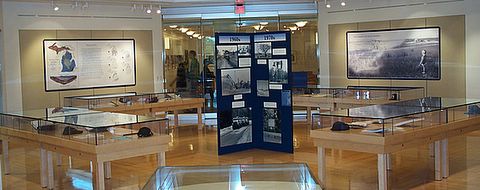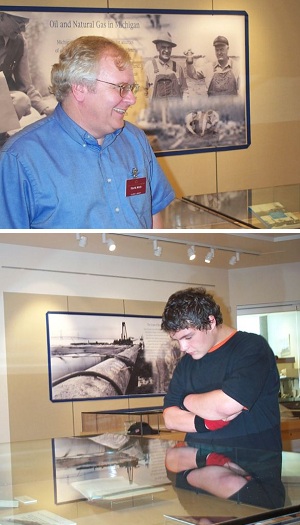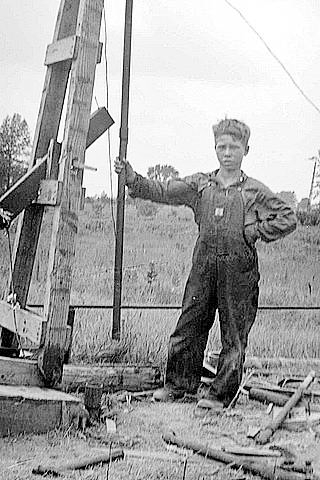by Bruce Wells | Jan 4, 2025 | Petroleum Pioneers
It took a while, but the 1957 well drilled on Mrs. Houseknecht’s dairy farm found a giant oilfield.
An exploratory well in southern Michigan had been drilled on and off for almost two years before revealing the state’s only giant oilfield in January 1957. The Michigan oil discovery at “Rattlesnake Gulch” on the dairy farm of Ferne Houseknecht tapped a petroleum-rich basin extending dozens of miles.
The story of the discovery of Michigan’s only giant oilfield is the stuff of dreams, according to Michigan historian and author Jack R. Westbrook. The state’s first oilfield, the Saginaw field, was found in 1925 and another field was discovered three years later, but there would be decades of “dry holes” before Mrs. Houseknecht convinced her uncle to finish drilling the well on her farm. (more…)
by Bruce Wells | Jun 27, 2024 | Energy Education Resources
Discoveries in the 1920s led to a giant oilfield in 1957.
A 1961 Clare County historical marker explains Michigan petroleum history began in 1886, but that Michigan State Geologist Alexander Winchell had reported that oil and natural gas deposits lay under Michigan’s surface as early as 1860.
“First commercial oil production was at Port Huron, where 22 wells were drilled, beginning in 1886,” the marker notes. “Total output was small. Michigan’s first oil boom was at Saginaw, where production began about 1925. About three hundred wells were drilled here by 1927, when Muskegon’s ‘Discovery Well’ drew oil men from all over the country to that field.”

“Michigan Oil & Gas History,” a 2005 Clarke Historical Library exhibit at Central Michigan University, Mount Pleasant. Photo by Kristin L. Wells.
The Clare County historical marker notes that the Mt. Pleasant field, discovered in 1928, “helped make Michigan one of the leading oil producers of the eastern United States. Mount Pleasant became known as the “Oil Capital of Michigan.”
Central Michigan University Oil Exhibit
In the summer of 2005, a special petroleum exhibit opened at Central Michigan University’s (CMU) Clarke Historical Library, Mount Pleasant.

“They work hard, take risks, prosper, and by and large benefit everybody,” noted Frank Boles, director of the Clarke Historical Library, about oil and natural gas producers. “What I didn’t understand about the industry is that these people all know each other.”

Frank Boles (top), director of the Clarke Historical Library, designed an exhibit creatively combining documents and photographs to capture the attention of students. Photos by Kristin L. Wells.
The library told their story with an “Oil and Natural Gas in Michigan” exhibit.
The state’s abundant oil production comes as a surprise to many, said Boles, who put the exhibit together with the cooperation of the Michigan Oil & Gas Association and the Michigan Oil & Gas Producers Educational Foundation.
Jack Westbrook, retired managing editor of Michigan Oil & Gas News magazine, marshaled the resources and worked tirelessly to ensure success, Boles said. “In a very real sense, there would be no exhibit if it were not for Jack.”

The exhibit was designed to designed to pique a visitor’s curiosity – and be transportable. The region’s students learned that Mount Pleasant, home to CMU, had its own oil boom in 1928 and today is known as the historical center of Michigan’s oil industry.
Exhibit visitors learned that more than 57,000 oil and gas wells had been drilled in their state since 1925 — and that Michigan ranks 17th in nationwide oil production and 11th in natural gas. More surprises awaited those students who looked more closely, Boles said.
“We’re about usage,” he explained. “Our profit is people coming in, using our resources, and hopefully learning something. We want our exhibits to prompt them to dig deeper.”
Golden Gulch of Oil
Clarke Historical Library visitors learned about late 1920s oil discoveries and that after decades of dry holes or small oil finds, a January 7, 1957, Houseknecht No. 1 well revealed Michigan’s largest oilfield, 29-miles-long. Ferne Houseknecht had convinced her uncle, Clifford Perry, to take time between his other farm projects to drill the historic well.
Learn more in Michigan’s Golden Gulch of Oil.
For the Clarke Historical Library exhibit, Boles used six walls and eleven cabinets to tell this and other stories, so careful planning was essential. He said that from the project’s outset, pursuit of community support, resources, and partners was essential.

Showing off his homemade cable tool rig in 1932, Earl “Red” Perry Jr., 12, was the nephew of Cliff Perry — who would discover Michigan’s largest oilfield in 1957. Photo courtesy Clarke Historical Library, Central Michigan University.
The exhibit began with storyboarding and the interactive process of writing and rewriting proposed text. Large photo formats with understandable text dominated the walls, while display cases featured unique artifacts and documents.
Visitors discovered a rich oil history and learned of the complex environmental issues Michigan has successfully addressed.
The 1970s “Pigeon River State Forest” ecological controversy was presented — along with its innovative solution. In 1976, Michigan became the first state in the nation to earmark state revenue generated through mineral, including oil and gas, activity for acquisition and improvement of environmentally sensitive or public recreation lands.

According to Jack Westbrook, all 83 Michigan counties have benefited from the fund’s $635 million collected from oil and gas revenues — and other states followed Michigan’s example. His book, Michigan Natural Resources Trust Fund 1976-2011: A 35 year Michigan investment heritage in Michigan’s public recreation future, can be found on Amazon Books (link below).
Visit the Clarke Historical Library.
_______________________
Recommended Reading: American Oil And Gas History Book: Michigan’s Golden Gulch Of Oil: The Great Depression (2021); At Home in Earlier Mt. Pleasant Michigan: A visit with our neighbors of the past (2021); Michigan Natural Resources Trust Fund 1976-2011: A 35-year Michigan Oil and Gas Industry Investment Heritage in Michigan’s Public Recreation Future (2011); Handbook of Petroleum Refining Processes
(2011); Handbook of Petroleum Refining Processes (2016).
(2016).
_______________________
The American Oil & Gas Historical Society preserves U.S. petroleum history. Become an annual AOGHS annual supporter and help maintain this energy education website and expand historical research. For more information, contact bawells@aoghs.org. Copyright © 2024 Bruce A. Wells. All rights reserved.
Citation Information – Article Title: “Michigan Petroleum History.” Authors: B.A. Wells and K.L. Wells. Website Name: American Oil & Gas Historical Society. URL: https://aoghs.org/energy-education-resources/exhibiting-michigan-petroleum-history. Last Updated: November 12, 2024. Original Published Date: June 19, 2014.





